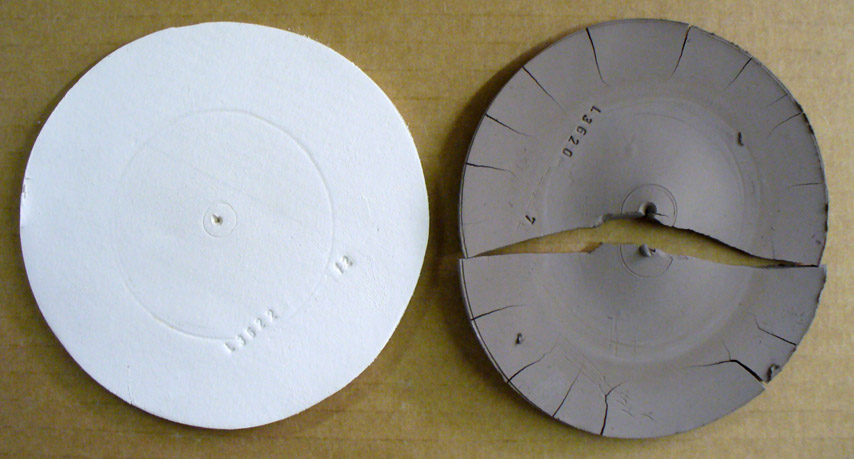| Monthly Tech-Tip | No tracking! No ads! |
How a kaolin and ball clay compare in a dry performance test
These are DFAC drying performance disks of a large-particle kaolin (OptiKast) and a ball clay (Plainsman A2). This test reveals a clay's response to uneven drying (these disks are dried with the center portion covered). The kaolin feels smoother yet its ultimate particles are ten to one hundred times bigger than a typical ball clay. Thus it shrinks much less. The ball clay has dramatically lower water permeability, water from the center protected portion resists migration to the outer edge during drying. When the inner section finally dried the outer was already rigid so it split the disk in two and pulled all the edge cracks. Most ball clays shrink more and crack worse than this (cracks concentric to the center also appear). So why use ball clay? This kaolin is so lacking in plasticity it was barely possible to even make this disk. And it is so weak that it can easily break just by handling it. Still, it is useful to make casting bodies. But the ball clay, when used as a percentage of a body mix, can produce highly plastic bodies than can be dried without trouble if done evenly.
Related Pictures
It dry shrinks much more yet cracks less. How is that possible?

This picture has its own page with more detail, click here to see it.
Two mugs have dried. The local terra cotta native clay on the left shrinks 7.5% on drying, the porcelain one on the right only 6% (it is made using Kentucky ball clay). Yet few pieces of the terra cotta are ever lost due to drying cracks, even if it is uneven! For example, in a batch of a dozen mugs none of these will be lost whereas one or two of the white ones will always crack. Why? Dry strength. The clay on the left is very strong in the dry state, likely double or triple the white clay (the strength is a by product of its high plasticity and particle size distribution profile). That strength is enough to more than counter the extra shrinkage.
Videos
Links
| Materials |
Kaolin
The purest of all clays in nature. Kaolins are used in porcelains and stonewares to impart whiteness, in glazes to supply Al2O3 and to suspend slurries. |
| Materials |
OptiKast Kaolin
|
| Materials |
Ball Clay
A fine particled highly plastic secondary clay used mainly to impart plasticity to clay and porcelain bodies and to suspend glaze, slips and engobe slurries. |
| Glossary |
Primary Clay
A clay deposit that is near the site of erosion and alteration. They have more mechanical impurities and fewer chemical and mineralogical impurities. Primary clays have larger particles and less plasticity. |
| Glossary |
Ultimate Particles
Utlimate particles of ceramic materials are finer than can be measured even on a 325 mesh screen. These particles are the key players in the physical presence of the material. |
| Minerals |
Ball Clay
Ball clay is the most common type of secondary clay. They are much more plastic than kaolin because |
| Tests |
Drying Factor
The DFAC Drying Factor test visually displays a plastic clay's response to very uneven drying. It is beneficial to show the relative drying performance of different clays. |
Got a Question?
Buy me a coffee and we can talk

https://digitalfire.com, All Rights Reserved
Privacy Policy

